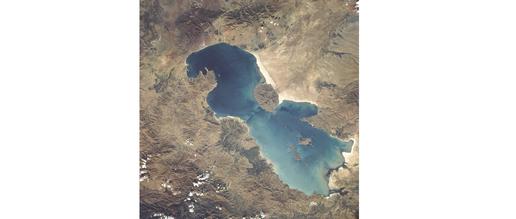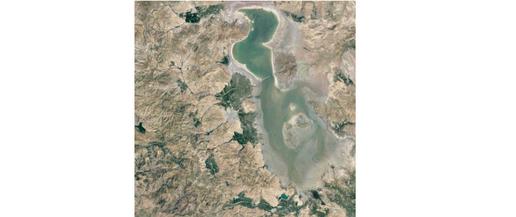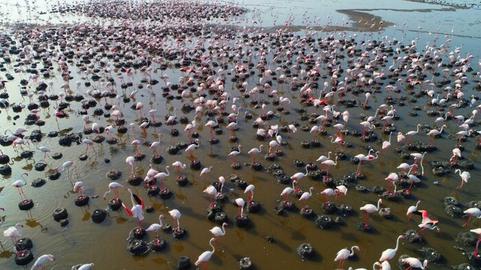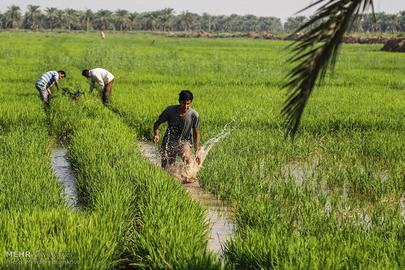Against the backdrop of the pandemic, sanctions and geopolitical tumult, scientists and researchers in Iran and the US have been working together on a ground-breaking project.
For the best part of a decade, official efforts have been underway in Iran to restore Lake Urmia: a massive body of water in northwest Iran, but whose volume has diminished by around 85 percent over the course of about 20 years.
The desiccation of this natural landmark was mostly caused by intensive agriculture, reservoir construction and water resource mismanagement. Farms over-drew from the rivers that flowed into the lake, and the water was then lost to the atmosphere by evapotranspiration through crop leaves. The impact to the local ecosystem, and with it people’s incomes, has been disastrous.
But research teams led by Dr. Somayeh Sima of Tarbiat Modares University in Tehran, and Dr. David E. Rosenberg from Utah State University, have hope. In a recent joint study examining data on the lake going back 40 years, they identified eight goals for restoration and calculated how each one might be met by Iranian officials tasked with managing Lake Urmia in the future.
There was a curious symmetry at play throughout the project. Dr. Rosenberg lives in Logan, Utah on the former lakebed of Lake Bonneville, a prehistoric lake in northern Utah that over thousands of years shrank to become the modern Great Salt Lake: one of the biggest saline lakes in the Western Hemisphere, which shares some intriguing characteristics with Lake Urmia.
“We both have our sister lakes that we cherish,” he told IranWire. “We cherish our lakes, not just us as researchers, but as millions of people in Iran and the US who live near these lakes and want to see them do well. The question is how to recover them.”
What Happened to Lake Urmia?
Lake Urmia covers some 5,200 square km and straddles the border of East Azerbaijan and West Azerbaijan provinces. Some five million Iranians live near the basin today, and the lake was formerly a haven for wildlife, home to 212 bird species, as well as a mainstay for crop irrigation.
For the past 20 years, however, intense agricultural development, reservoir construction, the use of illegal wells and reduced stream flows have seen water levels decline by about 6.5 meters, and 45 percent by area.
The turbo-charged salt levels in what little water remained decreased the numbers of local brine shrimp, which are very sensitive to salinity. Brine shrimp are thought to be the base of the food web at Lake Urmia and the birds that depend on them. After the lake level dropped, the flamingo count also dropped to zero.
Meanwhile, the diminishing water level opened land bridges between Lake Urmia’s southern islands and the shore. Predators use these bridges to reach the Kabudan and Ashk islands, where endangered species including Armenian sheep and Persian fallow deer live.
There are wide-ranging human costs to the lake’s destruction as well. In 2019 alone, lake reduction cost Iran an estimated $1.9 million in lost revenues from tourism, recreation, cultural heritage and educational activities. In addition, the shrinkage in the volume poses an immediate risk to the millions of Iranians who live near Lake Urmia by exposing them to lakebed dust. “They’re breathing in this dust,” Prof. Rosenberg said, “and it’s a health issue.”
More than 70 percent of farms in the basin are under 50,000 square meters in size. These small farms struggle to employ efficient crop and water management by themselves. Many rural families depend on water-intensive agriculture to get by, and farm sizes decrease as parents pass on their land to their children, shrinking their share of the land with each passing generation.
In the future, the researchers would like to study ways to help locals consolidate this carved-up land, potentially through farming co-operatives, and how to shift from low-income agricultural-dependant livelihoods to more sustainable, ecosystem-based modes of living.
What Did the Study Reveal?
In 2013 the Iranian government formed a specialist body, the Urmia Lake Restoration National Committee (ULRNC), to oversee restoration of the lake. Until recently it was believed that bringing the total lake level back to a uniform 1,274.1m across the whole body of water would be enough to restore the right level of salinity, and so bring back the brine shrimp.
By scrutinizing 40 years’ worth of experimental, field, satellite, and model data on the lake, the teams from Tarbiat Modares University and Utah State University found this one-size-fits-all approach might not be the best course of action.
Prof. Rosenberg specializes in water management to enhance ecosystems and has also worked on the Bear River in Utah and Colorado River in the southwest US. The study came about after Dr. Sima travelled to Utah on a five-month sabbatical in 2018.
The researchers found that, in fact, setting a uniform target water level would not solve Lake Urmia's problems. “Looking at the data, we see that brine shrimp densities and salinity vary over time,” Prof. Rosenberg said. “There’s no guarantee that if you recover the lake level to the government’s target of 1274.1 m you’ll get a salinity level that allows brine shrimp to thrive; there’s not a magic recipe.” Lake levels were also found to vary within a given year, and year-to-year.
Instead, the team identified eight goals that could be used in the restoration project. These included lower salinity, a higher brine shrimp count, increasing the flamingo population, reducing exposed lakebed dust, keeping water levels high enough to stop land bridges from forming between the four islands and the shore, and reducing the distance from tourist beaches to water deep enough to boat.
Different lake levels will impact the goals differently. The researchers suggested that Lake Urmia managers focus on the multiple goals, and track how each one is being met over time. As information about the lake improves, they can then adapt its management to meet the various objectives in the future.
What Needs to Happen?
The researchers also noted that historically, from 1992 to 2012, a “win-lose trade-off” between water level and agricultural revenues could be observed. In other words, the lake and farmers were competing for water.
Agricultural expansion was banned in 2013, helping to stabilize the lake level at about 1,271m. The team also found it would be possible to increase crop yield and revenue without any further expansion through better management.
The Iranian government has already begun treating wastewater from large cities and conveying it to Lake Urmia to increase the volume again. ”Water budgeting for the Lake Urmia basin can also be very helpful,” Prof. Rosenberg said. “Like a financial budget for a household or family, each year you track all the available water, the consumptive use, what flows to the lake, and lake evaporation.
“The lake’s water volume is the account balance and tells you how healthy or unhealthy the situation is. When the lake volume is low, the lake is hurting. As long as managers deliver more water to the lake than is being evaporated, the lake will be on a path to recovery.”
Sustaining a US-Iranian research collaboration required obtaining scarce funding and navigating the limits of the ongoing US sanctions on Iran. At the same time, Prof. Rosenberg said: “It’s been an absolutely amazing experience to work with them, to get to know my Iranian colleagues through sustained interactions over time, to share and compare experiences on Lake Urmia and Great Salt Lake.”
“Collaborations like this need help to continue and expand. Environmental problems are large. They’re complex and long-lasting. They require broad technical expertise. They need people in Iran and in the US who care, and who are willing to work together on these common environmental challenges despite the obstacles.”
Related coverage:
Water Tariffs to Increase in Iran Ahead of Summer Shortages
Desertification in Iran: A Ticking Time Bomb?
visit the accountability section
In this section of Iran Wire, you can contact the officials and launch your campaign for various problems





























comments